I have a Hyundai /Kia Sonata Hybrid Battery. The cells are 30 volt Lithium
I purchased a Grin Technologies Satiator Battery Charger Standard 12v to 52v
The purpose was to refurbish my own Hybrid Battery which was failing. Two of the batteries were very weak and after sitting a year 4 more swelled to big to fit in the enclosure. So replaced all of them.
I used a multimeter on the batteries that had dropped a little in voltage as I hear the goal is to get all cells at an equal level.
Used the multimeter setting 10 Meg Ohm Input DCV some of the battery cells which had a 19.5v to 21.5 up to 25.5 and 27.3 based on the MM readings.
Setup the Satiator Profile with the following.
We connected everything up and have the 30 v Lithium batteries connected to the Satiator and created a profile.
Lithium
VOLTAGE OF BATTERY = 30 V
AMPERS = 4.0
TRICKLE WAS SET AT AROUND 15 = I think the unit sets this itself?
END VOLTAGE = 27.3 WHICH IS WHAT WE ARE TRYING TO SET ALL THE BATTERIES TO
WHEN WE HIT START OR "FORCE START" THE BATTERY SHOWS ANYWHERE FROM 32.5 VOLTS TO 35.5 VOLTS ON EITHER OF THOSE BATTERIES.
THEN IT SHUTS OFF AUTOMATICALLY LIKE THE BATTERY HAD REACHED THE GOAL OR SETTING OF 27.3 OR GREATER.
IT DOES THIS FOR ALL OF THE BATTERIES NO MATTER THE VOLTAGE. COULD NOT GET HELP AT ALL EVEN WITH EMAIL FROM GRIN TECHNOLOGIES EBIKE.CA. I GUESS MY $400.00 PURCHASE DOES NOT WARRANT A CALL BACK FOR SUPPORT. GEESH! IS THIS FUNCTION NORMAL OPERATION? ALSO......
DOES THE SATIATOR READ THE CORRECT VOLTAGE FROM THE BATTERY POSTS POS + AND NEG - WHEN IT IS STARTED?
ALL THE BATTERIES DID THE SAME EXACT THING. VOLTAGE BOUNCED AROUND AND ALL READ GREATER THAN 30 + VOLTS
HOW DO I KNOW WHICH READING IS CORRECT OR IF THE UNIT IS CHARGING OR THE CELLS DO NOT NEED A CHARGE.
VERY CONFUSING.
I AM WILLING TO PAY ABOUT $60.00 PER HOUR FOR SUPPORT TO GET THE HELP I NEED. NO ONE AT JUSTANSWER.COM COULD HELP. I AM DESPERATE FOR ANY ADVICE YOU CAN OFFER. FEEL FREE TO CALL US IF IT IS EASIER. WE NEED TO GET THIS HYBRID BATTERY BACK ONLINE. PLEASE HELP. THANK YOU.
ROB BURDINE
919-272-1400
I purchased a Grin Technologies Satiator Battery Charger Standard 12v to 52v
The purpose was to refurbish my own Hybrid Battery which was failing. Two of the batteries were very weak and after sitting a year 4 more swelled to big to fit in the enclosure. So replaced all of them.
I used a multimeter on the batteries that had dropped a little in voltage as I hear the goal is to get all cells at an equal level.
Used the multimeter setting 10 Meg Ohm Input DCV some of the battery cells which had a 19.5v to 21.5 up to 25.5 and 27.3 based on the MM readings.
Setup the Satiator Profile with the following.
We connected everything up and have the 30 v Lithium batteries connected to the Satiator and created a profile.
Lithium
VOLTAGE OF BATTERY = 30 V
AMPERS = 4.0
TRICKLE WAS SET AT AROUND 15 = I think the unit sets this itself?
END VOLTAGE = 27.3 WHICH IS WHAT WE ARE TRYING TO SET ALL THE BATTERIES TO
WHEN WE HIT START OR "FORCE START" THE BATTERY SHOWS ANYWHERE FROM 32.5 VOLTS TO 35.5 VOLTS ON EITHER OF THOSE BATTERIES.
THEN IT SHUTS OFF AUTOMATICALLY LIKE THE BATTERY HAD REACHED THE GOAL OR SETTING OF 27.3 OR GREATER.
IT DOES THIS FOR ALL OF THE BATTERIES NO MATTER THE VOLTAGE. COULD NOT GET HELP AT ALL EVEN WITH EMAIL FROM GRIN TECHNOLOGIES EBIKE.CA. I GUESS MY $400.00 PURCHASE DOES NOT WARRANT A CALL BACK FOR SUPPORT. GEESH! IS THIS FUNCTION NORMAL OPERATION? ALSO......
DOES THE SATIATOR READ THE CORRECT VOLTAGE FROM THE BATTERY POSTS POS + AND NEG - WHEN IT IS STARTED?
ALL THE BATTERIES DID THE SAME EXACT THING. VOLTAGE BOUNCED AROUND AND ALL READ GREATER THAN 30 + VOLTS
HOW DO I KNOW WHICH READING IS CORRECT OR IF THE UNIT IS CHARGING OR THE CELLS DO NOT NEED A CHARGE.
VERY CONFUSING.
I AM WILLING TO PAY ABOUT $60.00 PER HOUR FOR SUPPORT TO GET THE HELP I NEED. NO ONE AT JUSTANSWER.COM COULD HELP. I AM DESPERATE FOR ANY ADVICE YOU CAN OFFER. FEEL FREE TO CALL US IF IT IS EASIER. WE NEED TO GET THIS HYBRID BATTERY BACK ONLINE. PLEASE HELP. THANK YOU.
ROB BURDINE
919-272-1400


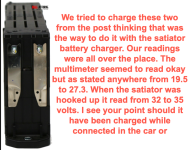
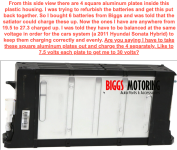
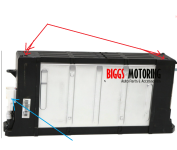

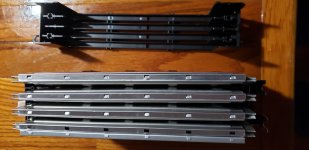
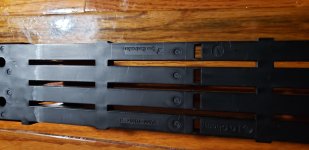
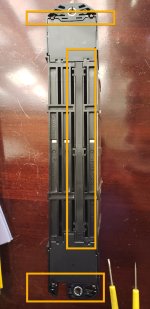

![cuVTJ3cf_400x400[1].jpg cuVTJ3cf_400x400[1].jpg](https://endless-sphere.com/sphere/data/attachments/187/187783-2e882aff084fc8f58f7730912e82bac0.jpg)